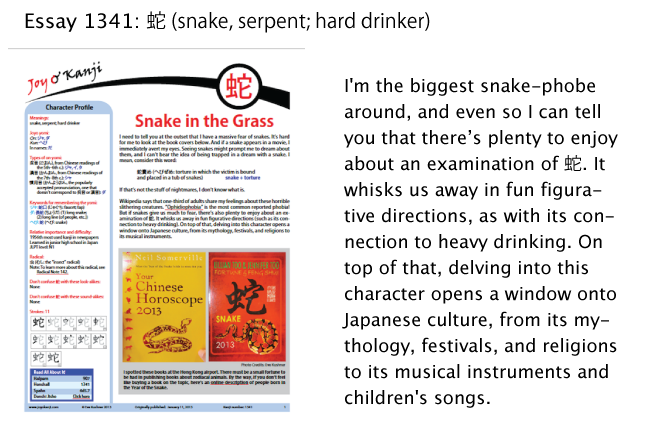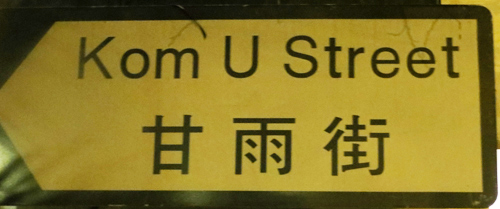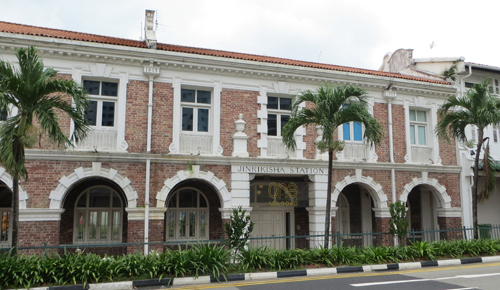Hanzi Heaven
Happy New Year! And welcome to the Year of the Snake. To kick off our celebration, I'm presenting essay 1341 on 蛇 (snake, serpent; heavy drinker). The third definition of this kanji may have a great deal to do with how you ushered in the new year!
Here's a preview of the essay:

As for me, I spent the holidays in Hong Kong, Singapore, and Malaysia, drinking in my surroundings as greedily as a serpent inhales whatever it consumes. (That's the 蛇-alcohol connection, by the way, as I've explained in the essay!)
I knew that the Chinese characters in those countries would interest me, but I thought I'd feel frustrated by them more than anything. Whenever I've encountered written Chinese, I've seen mainly Simplified hanzi, and as you surely know, it's hard for Japanese learners to make sense of characters from which half the strokes have disappeared! Even when I've seen Traditional characters, I've been hard pressed to glean much from them. It doesn't help that they come in streams uninterrupted by kana, so that I have no idea where one word ends and the next begins.

All Photo Credits: Eve Kushner
This T-shirt from Hong Kong gives a good impression of how impenetrable Chinese usually looks to me.
Expecting to understand next to nothing on the trip, I was thrilled to find that I recognized a great deal. For some reason, many signs seemed concise and practically pulsed with information that I could access. They called to me, making it hard to focus on anything else. How happy I was in a world awash in hanzi (that's the Chinese way of reading 漢字)! I emailed a few people, saying that I was in hanzi heaven. Here's just a brief sampling of what I mean.

What a clever use of 串 (くし: skewer) in Singapore!

In a Chinese environment, one can get a great on-yomi workout! It's not hard for kanji learners to recall the kun-yomi of あま and あめ (also あま!) for 甘 (sweet) and 雨 (rain), respectively. But if you asked me for either on-yomi, I might draw a blank, even though I wrote essay 1093 on 甘 not so long ago. The sign takes care of that in a flash; seeing KOM and U makes it easy to identify 甘 and 雨 as カン and ウ in a Japanese context. Oh, how sweet that rain is!

Does 米 (rice) stand in as "meter" for the Chinese? Apparently it does because I saw this type of sign in many places in Hong Kong.
Now that I've reunited with my reference material, I can see that Denshi Jisho lists "meter" as the first definition of 米 and presents メートル as an on-yomi! A Japanese friend tells me that a few Japanese signs make use of 米 as "meter," but not many.
My proofreader then told me this: "My sources say that the 米 is short for 米突, which is a transliteration of the French mètre; 米突 is read as read as mitu in Mandarin, which sounds quite like the French mètre (or the English 'meter'). Using on-yomi, the Japanese would read 米突 as べいとつ or まいとつ, which sound nothing like mètre or 'meter,' so the Japanese apparently just followed the Chinese on this."

I saw many more instances of 及 than of 米, often in freeway signs where it was easy to tell that 及 means "and." The Japanese word 及び (および) means the same thing, but I don't come across that word very often. By contrast, 及 seemed to loom over us while we sat in the back of taxis in traffic jams. I stared and stared at this character, realizing that it looks remarkably like an ampersand (&). Could that be the origin of our ampersand? I knew this was preposterous but hoped it was true.
It's not. I've now had a chance to check Wikipedia, and I've found that the ampersand dates back 1,900 years to the Roman era! So much for that! Still, what a convenient way to remember the meaning of 及び!

Jinrikisha! This graceful building in Singapore bears the romaji for the word 人力車 (じんりきしゃ), which means "rickshaw." A rickshaw is a vehicle (車) propelled by human (人) power (力)! Because of that clever combination, 人力車 was one of the first kanji compounds to make my heart leap, way back when.
The building certainly looks like an old station, but what's the Japanese connection? Ah, Wikipedia tells us this:
The Jinrikisha Station is Singapore's last reminder of the once ubiquitous rickshaw.... The rickshaw was first imported from Shanghai to Singapore in 1880 and by 1888, a Jinricksha Department was set up to register and license each rickshaw. By the end of the 19th century, there were about 1,000 rickshaw owners in Singapore. The demand for rickshaws was so great that Japan began manufacturing cheaper versions.
That must be the Japan connection.
Incidentally, jinricksha must be the Chinese version of the word. But can we be sure of that? Yes, we can! My proofreader has looked into the issue and says that the Chinese jinricksha comes from Japanese, just as the English "rickshaw" does.
Continuing this discussion of power (力), I was amused to see the following sign for Popeye's in the Hong Kong airport:

Doesn't this tell us that Popeye has "big power" (大力) and works on the water (水) with his hands (手)?! Yes, now that I have access to a Chinese dictionary, I've found that 大力水手 does indeed mean "Popeye (the Sailor)"! This breaks down as powerful, mighty (1st 2 hanzi) + sailor (last 2 hanzi). And my proofreader reminds me that the 手 in 水手 means "person," as is true in the Japanese 歌手 (かしゅ: singer) or 運転手 (うんてんしゅ: driver). Meanwhile, the 炸雞 in the sign means "fried chicken." The last character is a variant of 鶏 (chicken) and is non-Joyo in the Japanese context, as is 炸 (frying).

Right before the trip, I published essay 1047 on 菓 (confection). As I wrote there, the Chinese once used 果 to represent "fruit. Then, when 果 began to mean too many things that needed differentiation, someone took 果 and added 艹 (plant), producing 菓. For a little while, this continued to mean "fruit" but eventually came to mean "cake." Meanwhile, 果 still means "fruit," and I saw it all over Hong Kong and Singapore at stands selling fruit drinks.
In this Singapore sign above a fruit market, I saw both characters in one fell swoop! The larger writing on top gives us the old way of writing "fruit," whereas the smaller writing on the lower line brings us up to the modern day. How cool is that?!
On the trip I enjoyed not only the unexpected connections between such characters but also a mind-boggling chain of human connection. In Hong Kong, I had the pleasure of meeting a British woman named Janet (and her parents and daughter), feeling as though I'd known her for ages, though it was the first time I'd seen her face. Perhaps the familiarity had to do with her being the friend of a friend of a friend of a friend of a friend! (Lots of friendliness there!)
Here's what I mean:
Lonnie Wiig in Oregon edited my book Crazy for Kanji several years ago, and we've kept in touch since then.
He introduced me electronically to Mary Sisk Noguchi, whom many of you have known as the "Kanji Clinic" columnist in the Japan Times. More on her in a moment.
Mary introduced me to Ester, a kanji enthusiast in Chile.
Ester in turn connected me with Haru-san, a Japanese man who has recently moved to Chile.
And once I began emailing Haru-san, he said that if I were headed to Hong Kong, I should look up a British woman, Janet, who lives there now.
So I did, exchanging a few emails with her before the trip. Janet and I hit it off, talking (among other things) about time she spent in Massachusetts. Eventually we realized that we share a friend in Massachusetts. In fact, that friend, Karen, has been like a mom to me for years!
This world is tiny!
One sad note before I close. There has been a rupture in that chain of connections and in our kanji community. Mary Sisk Noguchi struggled with cancer all last year, and she died in Nagoya on December 21. Her husband blogged in English about her day-to-day life in hospice, including frank details about her condition, as well as pictures that you may find disturbing. At the same time, it's refreshing that he was so open about everything, and the blog overflows with the love that he and their children clearly felt for Mary.
Many of you discovered kanji through Mary, so I thought you would want to know about this tremendous loss. In fact, you may have found me through one of the links on her site to my book and to Joy o' Kanji. Ever since she received an advance copy of Crazy for Kanji, Mary eagerly supported me and my work. She could have felt annoyed that I had trespassed on her territory, and she could easily have been contemptuous that I dared to write about kanji with so little experience under my belt. On the contrary, she bolstered me.
Four years ago this month, before I hosted a booth at my first-ever kanji book event—the Lunar New Year celebration at the Oakland Museum—I joked to her that I felt like a fraud. I'm neither Japanese nor Chinese, so I actually felt like a double fraud. Plus my book hadn't even come out yet, and all I had to offer people was a flimsy postcard about it! Mary skipped right over the joking and wrote me back with complete sincerity: "Congratulations and enjoy the event to the fullest. You deserve it! I urge you not to fret about bumping into native speakers. Your book is completely honest in presenting the author as a non-native speaker of Chinese/Japanese who came to a love of kanji as an adult and wants to share that love with other non-native speakers. That is the thing that makes your book so refreshing and unique: it is written by a kanji LEARNER. The shelves are sagging with books written by native-speaking 'experts,' so hold your head up high for creating something different."
I replied, "You will forever be my hero for asserting your expertise without succumbing to all these fears (or so it seems!)." And so she is.
"Let Kushner transport you to Kanji Heaven," she wrote in her review of my book, a quotation that's on the back cover. How strange it is now to think of heaven in connection with Mary. She will be missed.

Comments